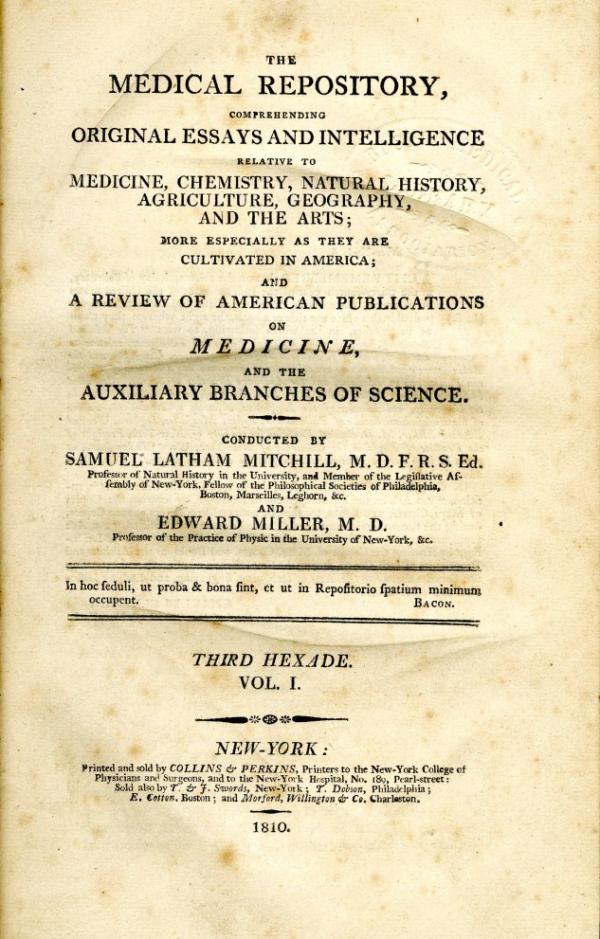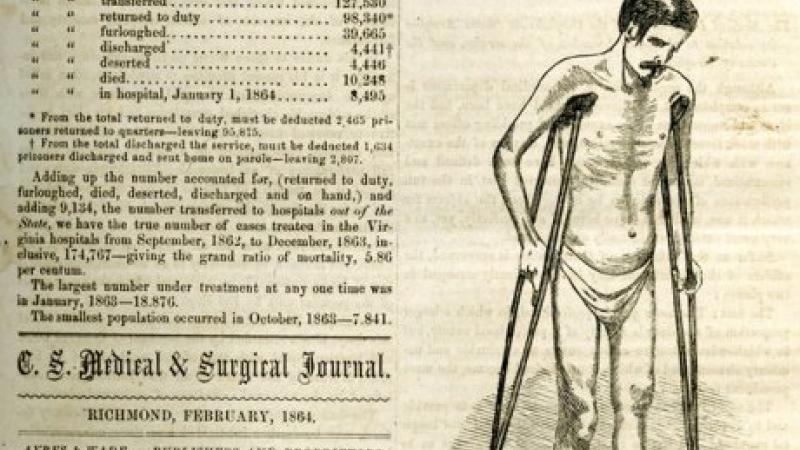Medicine and the Humanities. Part III: Medical Heritage Library

Medical Repository, v. 1 (1810), title page.
Courtesy of Medical Heritage Library

Medical Repository, v. 1 (1810), title page.
Courtesy of Medical Heritage Library
Historian Charles Rosenberg once wrote that hospitals have “reproduced in microcosm the history of a larger society” (Charles Rosenberg, The Care of Strangers: the Rise of America's Hospital System. New York, NY Basic Books 1987, p.4).
At first glance, this observation might seem surprising, but its broad connotation is undeniable: health, illness, and medical attention touch everyone’s lives and can have a decisive influence on human behavior, individually and collectively. Humanities scholars have recognized the central role of health and medicine in American and world history for several decades, but this is a field of research that remains very much in a state of growth and transformation. One manifestation of this is a recent increase in efforts to preserve and facilitate online access to rich collections of historical documents, images, and publications related to the history of medicine.
Over the next couple of weeks, we are profiling three major preservation and access projects funded through NEH’s Humanities Collections and Reference Resources program that cover subject matter of national, and indeed international, scope and importance. Part I featured the University of Michigan’s Center for the History of Medicine’s effort to document systematically the deadly influenza outbreak of 1918-19, in part to understand how we may better prepare as a society for future outbreaks. Part II featured the University of Cincinnati’s archive of Dr. Albert Sabin, the scientist who developed the oral polio vaccine that helped eradicate the disease, and Part III will feature a collaborative project involving some of the nation’s leading medical libraries to digitize historical medical journals, including the first medical journal published in the United States, Medical Repository (1797-1824).
As these projects illustrate, the history of medicine bridges almost every domain of the humanities, from the study of philosophy and ethics to the examination of everyday social and cultural history. Far from being a narrow subfield of study, it opens a pathway for exploring some of the most fundamental questions of human experience over time.
Medical Heritage Library
Medical journals might not immediately leap to mind as exceptional humanities research sources. However, such items from past centuries, indeed, often prove to be compelling social documents. Take, for example, the Confederate States Medical and Surgical Journal, published in Richmond in 1864-65. Its expressed intent was “to lay the foundation of a Southern medical literature on a firm and enduring basis,” on par with its well-established northern counterparts, such as the Boston Medical and Surgical Journal (forerunner of the New England Journal of Medicine). The publication is filled with reports on the progress of the war, depictions of wound treatment and surgical facilities, hospital reports, descriptions of the uses and supply of drugs, developments in prosthetics, discussions of disease outbreaks, and more.
Humanities scholars and others are fortunate that a number of prominent medical libraries in the United States and elsewhere have worked for many years to preserve an extraordinary corpus of medical periodicals spanning virtually the entirety of this nation’s history. Those institutions have now banded together to ensure that the printed legacy of medical history is made easily available for all to discover and read. The resulting Medical Heritage Library (MHL) has rapidly become the leading online collection of historical publications pertaining to health and medical practice. Created in 2009, the MHL is the product of a consortium of the nation’s premiere special collections in this subject area, including the Francis A. Countway Library of Medicine at Harvard Medical School, the Harvey Cushing/John Hay Whitney Medical Library at Yale University, the Augustus C. Long Health Sciences Library at Columbia University, the New York Public Library, the College of Physicians of Philadelphia, the Alan Mason Chesney Medical Archives at John Hopkins University, and the National Library of Medicine along with Great Britain’s Wellcome Library. With initial support from the Alfred P. Sloan Foundation, the MHL has digitized some 33,000 monographs, pamphlets, and films contained in participating libraries.
A 2012 award from NEH to the MHL’s coordinating entity, the Open Knowledge Commons, is supporting the digitization of approximately 1.7 million pages from 200 medical journals published between 1797 and 1923. The project will enable free online access to complete runs of the nation’s earliest journals, housed in the medical libraries of Columbia, Harvard, and Yale Universities and The College of Physicians of Philadelphia. The National Library of Medicine and other MHL collaborators will assist by providing journal volumes that the primary participants do not hold.
The collection will span the dates 1797 to 1923, beginning with the nation’s first medical journal, Medical Repository (1797-1824). This was a period of intensive research, discovery, and experimentation in all areas of medicine, spawning a wide array of specialized fields such as neurology, psychiatry, obstetrics, pediatrics, and medical jurisprudence. The journals also reflect the emergence of various alternative or sectarian medical practices during this time, including homeopathy and botanic medicine, as well as pseudoscientific pursuits such as phrenology and animal magnetism. Together, these sources offer a remarkable record of society’s efforts to improve its wellbeing and longevity, providing abundant information on social questions and conditions pertaining to race, ethnicity, gender, religion, the economics of health care, the impact of global epidemics, evolving perceptions of diseases, and much more. The digital surrogates will be preserved and made freely available over the next two years on the Internet Archive and the Hathi Trust collaborative digital repository.
Further Readings
Be sure to read Part I and Part II of our series Medicine and the Humanities.
In addition to these efforts, the Division of Preservation and Access has supported a number of other projects over several decades that pertain directly or indirectly to the history of medicine.
- RT-20933-88 ENCYCLOPEDIA OF BIOETHICS Revision Project
1988
The revision of the first edition of the ENCYCLOPEDIA OF BIOETHICS, a reference work for the field of study dealing with ethical questions in the life sciences, health, and health.
Georgetown University - RT-21069-89 History and Geography of Human Disease
1989
The preparation of a three-volume history and geography of human disease.
Bowling Green State University - PH-20639-93 Machine-readable Cataloguing of Medical Artifacts
1993
The creation of machine-readable cataloguing records for l7,000 historical and medical artifacts held in seven academic health sciences libraries throughout the state.
Cleveland Medical Library Association - PA-23141-98 Arranging and Describing Records Documenting the History of Botany
1998
The arrangement and description of organizational records, personal papers, and field notes documenting the history of botany since the mid-19th century.
New York Botanical Garden - PA-51306-05 Cataloging Botanical Literature from the 15th through 20th Centuries
2005
Cataloging 3,537 rare books, serials, and monographic series related to the history of horticulture and landscape design in the Western world from 1400 to 1900.
Chicago Botanic Garden - PA-51723-06 Preservation Needs Assessment
2006
A preservation needs assessment of the academy's library facility and the preparation of recommendations for a comprehensive preservation plan, with particular focus on materials that chronicle the history of medicine.
New York Academy of Medicine - PG-51141-11 General Preservation Assessment for the Archives of the History of American Psychology
2011
A general preservation assessment and the purchase of storage equipment to better preserve the University's archival, audiovisual, and artifact collections documenting the history of psychology. The collection includes home video footage of Sigmund Freud.
University of Akron, Main Campus



